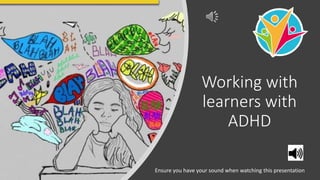
Working with ADHD Learners (1).pptx
- 1. Working with learners with ADHD Ensure you have your sound when watching this presentation
- 2. Learning Aims • Confirm the meaning of ADHD (Attention Deficit Hyperactivity Disorder) • Explore the types of ADHD • Look at the characteristics learners with ADHD may portray • Highlight some strategies to support learners with ADHD Working with learners with ADHD
- 3. ADHD – THE SCIENCE • ADHD is a cognitive and behavioural disorder that is exhibited through hyperactive, impulsive and inattentive behaviour. • 2% to 5% of United Kingdom school aged children are affected, with boys showing a higher rate of diagnosis than girls. • For some children, the symptoms of ADHD go into remission after puberty, but many continue with symptoms into their adult lives.
- 6. ADHD CHARACTERISTICS Hyperactivity/Impulsivity Inattentive Other • Fidgets in class or walks around with no particular aim. • Talks a lot, interrupts. • Runs at inappropriate times; takes unnecessary risks. • Has trouble enjoying leisure activities quietly. • Has difficulty waiting for their turn. • Answers verbal questions before they have been completed. • Intrudes on the activities or conversations of their peers. • Says or does things without considering the consequences. • Gets bored easily. • Careless mistakes in coursework, does not pay attention to detail. • Finds it hard to stay focussed on task. • Does not appear to be listening when spoken to directly. • Does not follow instructions and fails to finish coursework (not due to oppositional behaviour or failure to understand instructions). • Struggles to organise activities. • Avoids tasks that require a lot of concentration e.g. homework. • Loses equipment e.g. pens, pencils, books etc. • Is distracted from tasks easily. • Is forgetful about routines of daily activities. • Impatient. • Misreads social cues, sometimes misinterprets remarks as hostile. • Can over-react and be prone to challenging behaviour. • Inflexible personality. • Sleep and appetite problems
- 7. Communication • Ask learners to repeat instructions/ideas back to check they are paying attention. • Don’t finish the learner’s sentences for them and discourage them from doing the same. • Gently bring the learner’s attention back to the teaching topic if they go off track. • Don’t take blunt comments personally but explain why they might cause offence. • Be positive and calm, learners may have low self-esteem due to years of being criticised or punished for their impulsive words. • Don’t rely on verbal instructions. Give written instructions/information to allow learners to concentrate and absorb the information later.
- 8. Behaviour • Display clear and concise rules and consistently enforce them. • Offer more positive reinforcement than negative consequences. Focus on one particular behaviour at a time to improve and reward it freely. • Give negative consequences firmly and without emotion. • Be respectful. Learners and their peers know they stand out and therefore need as little negative attention as possible. • Teach a ‘Stop and Think’ method where learners wait five seconds before responding to a question to try to reduce inappropriate comments.
- 9. Behaviour continued… • Anticipate potentially difficult situations and discuss solutions ahead of time. • If your learner misinterprets social situations, discuss alternative interpretations and encourage them to be open minded in how they ‘read’ future situations. • Make turn-taking, listening, and helping each other a part of classroom culture so all learners place importance on being respectful. • Create a subtle signal to let the learner know they are off task. • Give rewards/punishments as quickly after the behaviour as possible. • Consider why bad behaviour has arisen; is the work too easy/ hard/boring? A quick diversion onto another topic may help.
- 10. Maximising the Learner’s Potential • Repeat information frequently. • Allow for breaks to help maintain concentration. • Use varied methods of presentation. • Assign different roles to the learner to prevent boredom; being a peer tutor, writing information on the board, collecting books etc. • Make worksheets simple; underline important words, keep distracting graphics to a minimum and use a large, plain font. • Use co-operative learning groups with assigned roles to provide variation. • Modify test conditions; reduce distractions as much as possible and allow for breaks. • Consider how best to assess learning; recording verbal answers may prove their understanding better than a formal test. • Use praise to improve self-esteem; be specific about why you are giving it.
- 11. Improving Study Skills • Ask learners to sit at the front of the class or closest to the board/screen. • Teach the learner how to use coloured dividers and (online) folders to organise work. • Split large assignments into smaller sections with separate due dates. • Create a checklist for the learner to tick off completed steps in a project/assessment. • Give constant oral and written reminders about assignment due dates. • Use colour coding to differentiate subject/units/modules. • Encourage the learner to plan their learning/assessments; use lists, planners and reminders.
- 12. Thank you for watching…